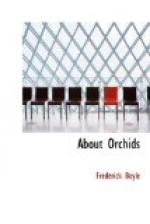Recently I have been privileged to see another, the most impressive to my taste, of all the lovely genus. It is called D. atro-violaceum. The stately flowers hang down their heads, reflexed like a “Turban Lily,” ten or a dozen on a spike. The colour is ivory-white, with a faintest tinge of green, and green spots are dotted all over. The lobes of the lip curl in, making half the circumference of a funnel, the outside of which is dark violet-blue; with that fine colour the lip itself is boldly striped. They tell me that the public is not expected to “catch on” to this marvel. It hangs its head too low, and the contrast of hues is too startling. If that be so, we multiply schools of art and County Council lectures perambulate the realm, in vain. The artistic sense is denied us.
Madagascar also will furnish some astonishing novelties; it has already begun, in fact—with a vengeance. Imagine a scarlet Cymbidium! That such a wonder existed has been known for some years, and three collectors have gone in search of it; two died, and the third has been terribly ill since his return to Europe—but he won the treasure, which we shall behold in good time. Those parts of Madagascar which especially attract botanists must be death-traps indeed! M. Leon Humblot tells how he dined at Tamatave with his brother and six compatriots, exploring the country with various scientific aims. Within twelve months he was the only survivor. One of these unfortunates, travelling on behalf of Mr. Cutler, the celebrated naturalist of Bloomsbury Street, to find butterflies and birds, shot at a native idol, as the report goes. The priests soaked him with paraffin, and burnt him on a table—perhaps their altar. M. Humblot himself has had awful experiences. He was attached to the geographical survey directed by the French Government, and ten years ago he found Phajus Humblotii and Phajus tuberculosus in the deadliest swamps of the interior. A few of the bulbs gathered lived through the passage home, and caused much excitement when offered for sale at Stevens’ Auction Rooms. M. Humblot risked his life again, and secured a great quantity for Mr. Sander, but at a dreadful cost. He spent twelve months in the hospital at Mayotte, and on arrival at Marseilles with his plants the doctors gave him no hope of recovery. P. Humblotii is a marvel of beauty—rose-pink, with a great crimson labellum exquisitely frilled, and a bright green column.
Everybody who knows his “Darwin” is aware that Madagascar is the chosen home of the Angraecums. All, indeed, are natives of Africa, so far as I know, excepting the delightful A. falcatum, which comes, strangely enough, from Japan. One cannot but suspect, under the circumstances, that this species was brought from Africa ages ago, when the Japanese were enterprising seamen, and has been acclimatized by those skilful horticulturists. It is certainly odd that the only “cool” Aerides—the




